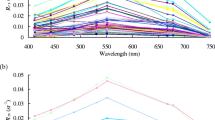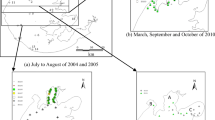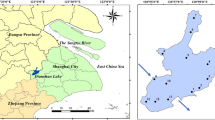Abstract
In this study, semi-analytical algorithms such as two-band and three-band models were used to estimate the chlorophyll-a (Chl-a) concentration in the turbid river using an airborne hyperspectral imagery. In order to select the optimal wavelength band to be used in the empirical equation, surface water was collected at the same time of acquisition of the aerial hyperspectral imagery. The spectral characteristic of the Chl-a, PC, CDOM, NAP, and phytoplankton were analyzed from by collected samples. The concentrations of PC and CDOM which affect the spectral characteristics to Chl-a were low and there was no change over time. So the range of wavelengths was able to broaden than the existing cases. As the result of widening the wavelength band, the two-band and three-band models were found to be higher R2 than the results obtained by using the existing formula. Because the three-band model is more statistical significance than the two-band model, it is more appropriate to estimate the chlorophyll-a concentration in the turbid river. However, the Chl-a concentration of this study was relatively low at 45 mg/m3, and the effect of PC and CDOM also was small. To estimate the correct Chl-a concentration, data such as airborne hyperspectral imagery and water sample need to be accumulated in different years and the correlation between optical properties and concentration should be thoroughly analyzed.







Similar content being viewed by others
References
Paerl, H. W., Fulton, R. S., Moisander, P. H., & Dyble, J. (2001). Harmful freshwater algal blooms, with an emphasis on cyanobacteria. The Scientific World Journal, 1, 76–113.
Schalles, J. F., Gitelson, A. A., Yacobi, Y. Z., & Kroenke, A. E. (1998). Estimation of chlorophyll a from time series measurements of high spectral resolution reflectance in an eutrophic lake. Journal of Phycology, 34(2), 383–390.
Richardson, L. L. (1996). Remote sensing of algal bloom dynamics. BioScience, 46(7), 492–501.
Landgrebe, D. A. (1999). Some fundamentals and methods for hyperspectral image data analysis. In Systems and technologies for clinical diagnostics and drug discovery II (Vol. 3603, pp. 104–114).
Maity, S., Mondal, I., Das, B., Mondal, A. K., & Bandyopadhyay, J. (2017). Pollution tolerance performance index for plant species using geospatial technology: Evidence from Kolaghat Thermal Plant area, West Bengal, India. Spatial Information Research, 25(1), 57–66.
Kim, S. H., Lee, K. S., Ma, J. R., & Kook, M. J. (2005). Current status of hyperspectral remote sensing: Principle, data processing techniques, and applications. Korean Journal of Remote Sensing, 21(4), 341–369.
Govender, M., Chetty, K., & Bulcock, H. (2007). A review of hyperspectral remote sensing and its application in vegetation and water resource studies. Water Sa, 33(2), 145–151.
Patra, P. P., Dubey, S. K., Trivedi, R. K., Sahu, S. K., & Rout, S. K. (2017). Estimation of chlorophyll-a concentration and trophic states in Nalban Lake of East Kolkata Wetland, India from Landsat 8 OLI data. Spatial Information Research, 25(1), 75–87.
Park, Y. J., Jang, H. J., Kim, Y. S., Baik, K. H., & Lee, H. S. (2014). A research on the applicability of water quality analysis using the hyperspectral sensor. Journal of the Korean Society for Environmental Analysis, 17(3), 113–125.
Gitelson, A. A., Schalles, J. F., & Hladik, C. M. (2007). Remote chlorophyll-a retrieval in turbid, productive estuaries: Chesapeake Bay case study. Remote Sensing of Environment, 109(4), 464–472.
Sengpiel, R. E. (2007). Using airborne hyperspectral imagery to estimate chlorophyll a and phycocyanin in three central Indiana mesotrophic to eutrophic reservoirs. Doctoral dissertation.
Moses, W. J., Gitelson, A. A., Perk, R. L., Gurlin, D., Rundquist, D. C., Leavitt, B. C., et al. (2012). Estimation of chlorophyll-a concentration in turbid productive waters using airborne hyperspectral data. Water Research, 46(4), 993–1004.
Olmanson, L. G., Brezonik, P. L., & Bauer, M. E. (2013). Airborne hyperspectral remote sensing to assess spatial distribution of water quality characteristics in large rivers: The Mississippi River and its tributaries in Minnesota. Remote Sensing of Environment, 130, 254–265.
Fan, C. (2014). Spectral analysis of water reflectance for hyperspectral remote sensing of water quality in estuarine water. Journal of Geoscience and Environment Protection, 2(2), 19–27.
Awad, M. (2014). Sea water chlorophyll-a estimation using hyperspectral images and supervised artificial neural network. Ecological Informatics, 24, 60–68.
Kim, T. W., Shin, H. S., & Suh, Y. C. (2014). Airborne hyperspectral imagery availability to estimate inland water quality parameter. Korean Journal of Remote Sensing, 30(1), 61–73.
Gwak, B. R., & Kim, I. K. (2016). Characterization of water quality in Changnyeong-Haman weir section using statistical analyses. Journal of Korean Society of Environmental Engineers, 38(2), 71–78.
Ministry of Environment. (2017). Occurrence and response of algal-bloom. Report, Ministry of Environment, Daejeon, Korea.
Dall’Olmo, G., & Gitelson, A. A. (2006). Absorption properties of dissolved and particulate matter in turbid productive inland lakes. Ocean Optics Conference, f Ocean Optics XVIII, pp. 1–15.
Pyo, J., Pachepsky, Y., Baek, S. S., Kwon, Y., Kim, M., Lee, H., et al. (2017). Optimizing semi-analytical algorithms for estimating chlorophyll-a and phycocyanin concentrations in Inland Waters in Korea. Remote Sensing, 9, 542.
Gitelson, A. (1992). The peak near 700 nm on radiance spectra of algae and water: Relationships of its magnitude and position with chlorophyll concentration. International Journal of Remote Sensing, 13(17), 3367–3373.
Dekker, A. (1993). Detection of the optical water quality parameters for eutrophic waters by high resolution remote sensing. Ph.D. Thesis, Vrije University, Amsterdam, The Netherlands.
Gitelson, A., Keydan, G., & Shishkin, V. (1985). Inland waters quality assessment from satellite data in visible range of the spectrum. Soviet Remote Sensing, 6, 28–36.
Dall’Olmo, G., Gitelson, A. A., & Rundquist, D. C. (2003). Towards a unified approach for remote estimation of chlorophyll-a in both terrestrial vegetation and turbid productive waters. Geophysical Research Letters, 30(18), 1938.
Gitelson, A. A., Gritz, Y., & Merzlyak, M. N. (2003). Relationships between leaf chlorophyll content and spectral reflectance and algorithms for non-destructive chlorophyll assessment in higher plant leaves. Journal of Plant Physiology, 160(3), 271–282.
Witte, W. G., Whitlock, C. H., Usry, J. W., Morris, W. D., &Gurganus, E. A. (1981). Laboratory measurements of physical, chemical, and optical characteristics of Lake Chicot sediment waters. NASA technical paper.
Zhou, L., Roberts, D. A., Ma, W., Zhang, H., & Tang, L. (2014). Estimation of higher chlorophyll a concentrations using field spectral measurement and HJ-1A hyperspectral satellite data in Dianshan Lake, China. ISPRS Journal of Photogrammetry and Remote Sensing, 88, 41–47.
Acknowledgements
This work (Grants No. 2015000540009) was supported by Geo-Advanced Innovative Action (GAIA) funded Ministry of Environment and Korea Environmental Industry Technology Institute in 2015.
Author information
Authors and Affiliations
Corresponding author
Rights and permissions
About this article
Cite this article
Jeon, EI., Kang, SJ. & Lee, KY. Estimation of chlorophyll-a concentration with semi-analytical algorithms using airborne hyperspectral imagery in Nakdong river of South Korea. Spat. Inf. Res. 27, 97–107 (2019). https://doi.org/10.1007/s41324-018-0204-0
Received:
Revised:
Accepted:
Published:
Issue Date:
DOI: https://doi.org/10.1007/s41324-018-0204-0




